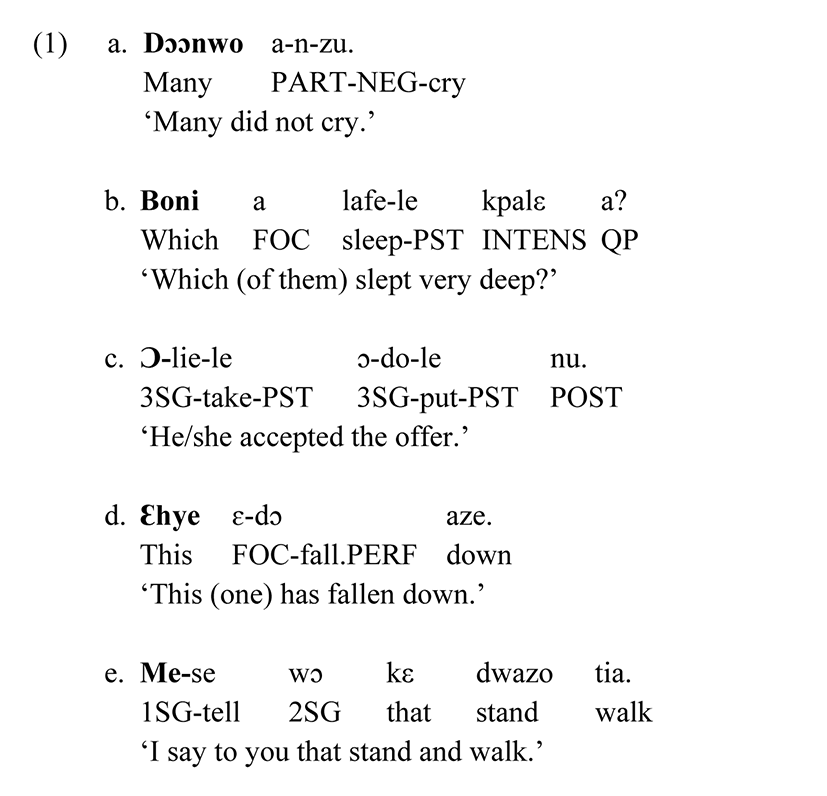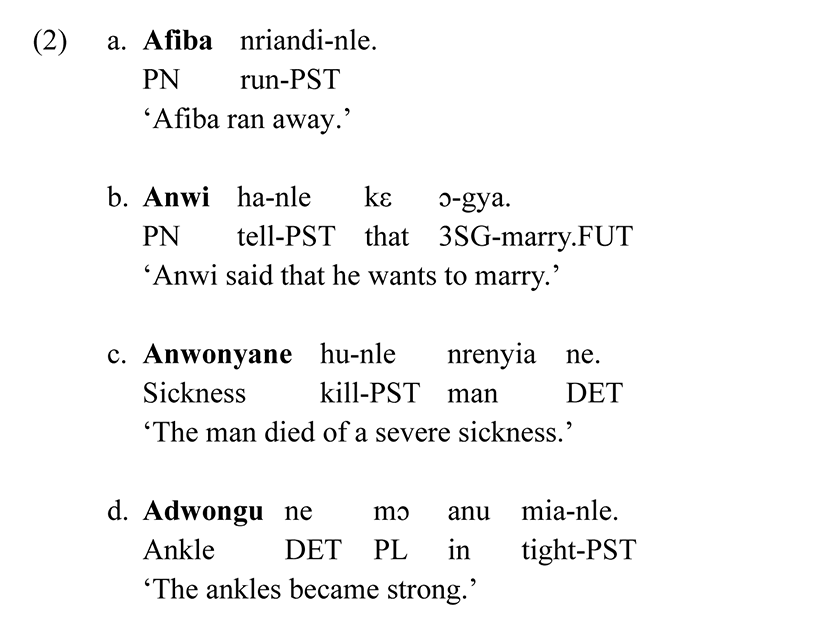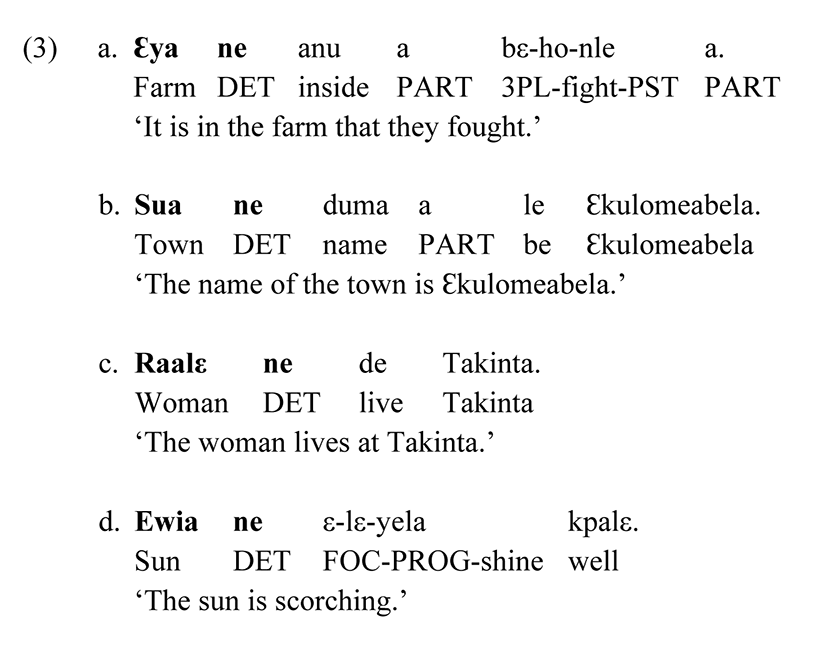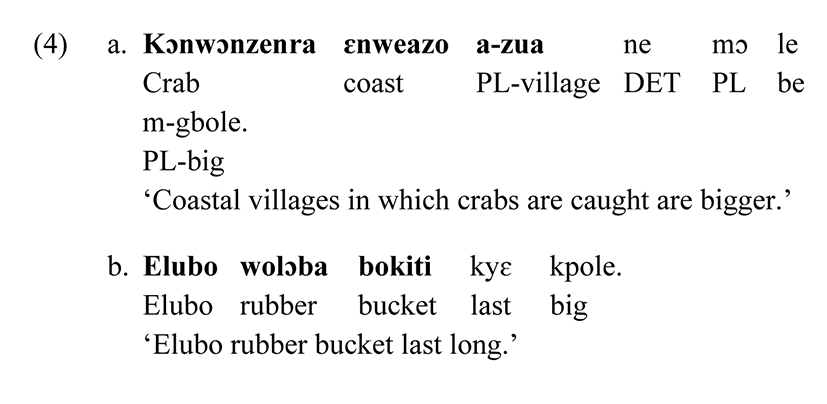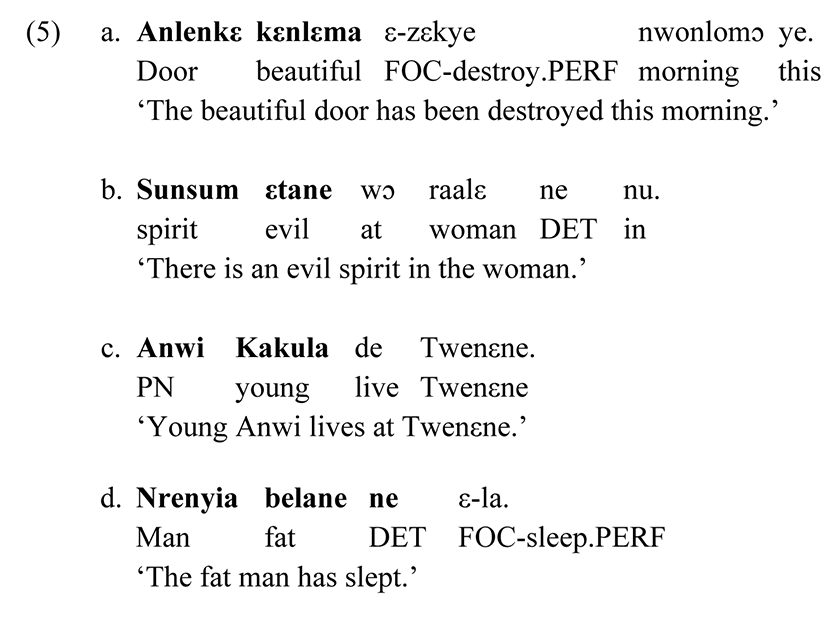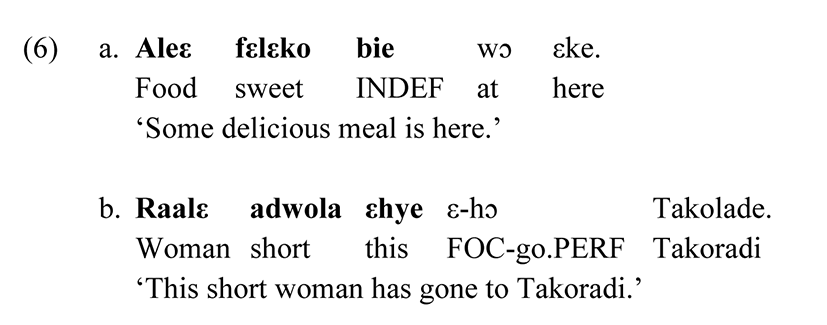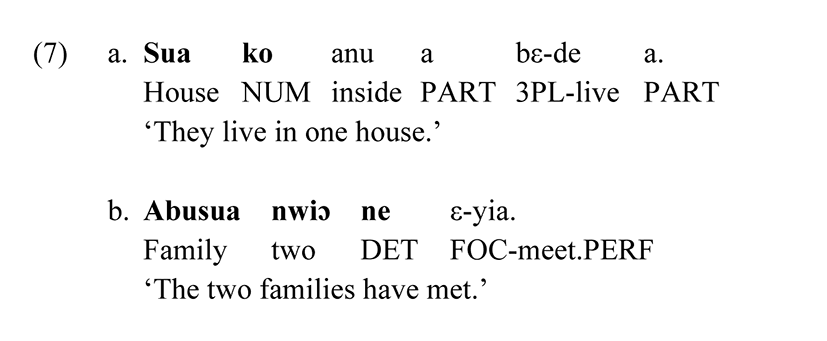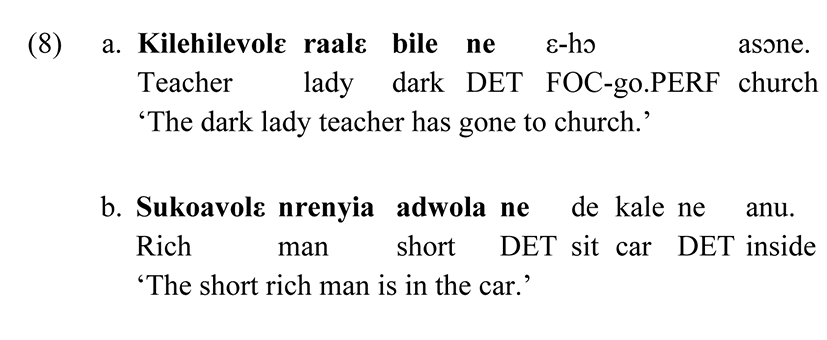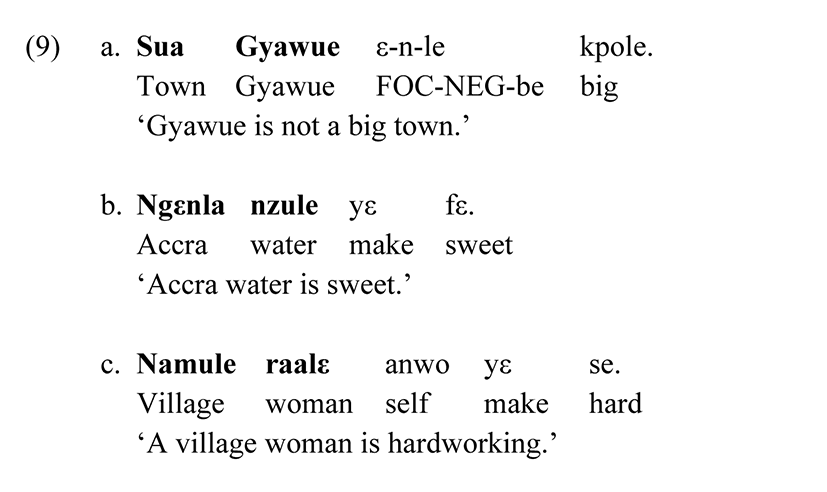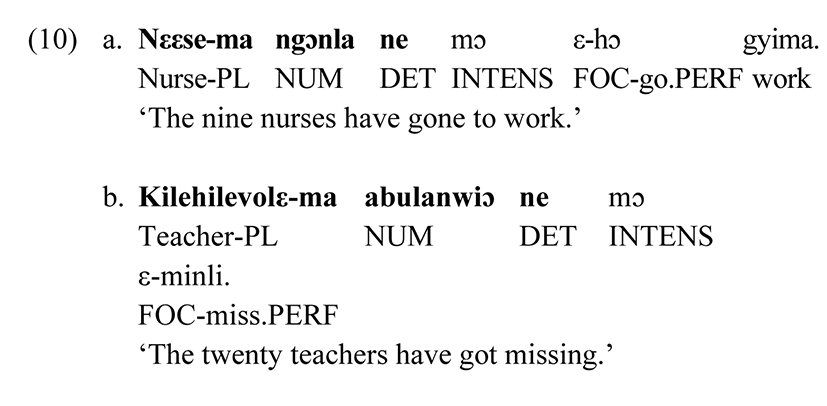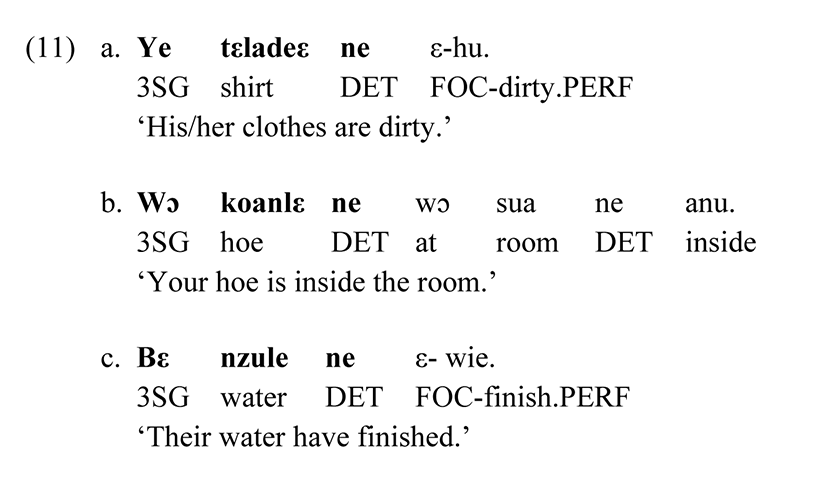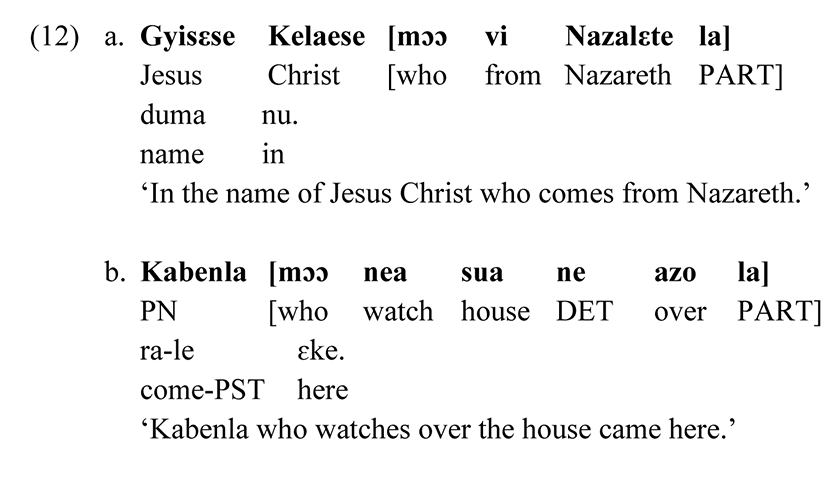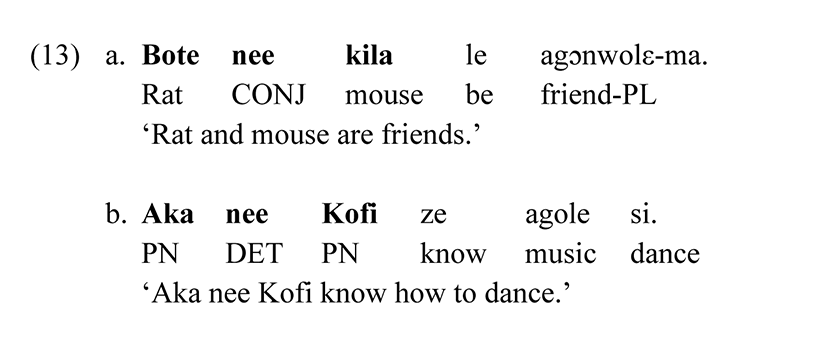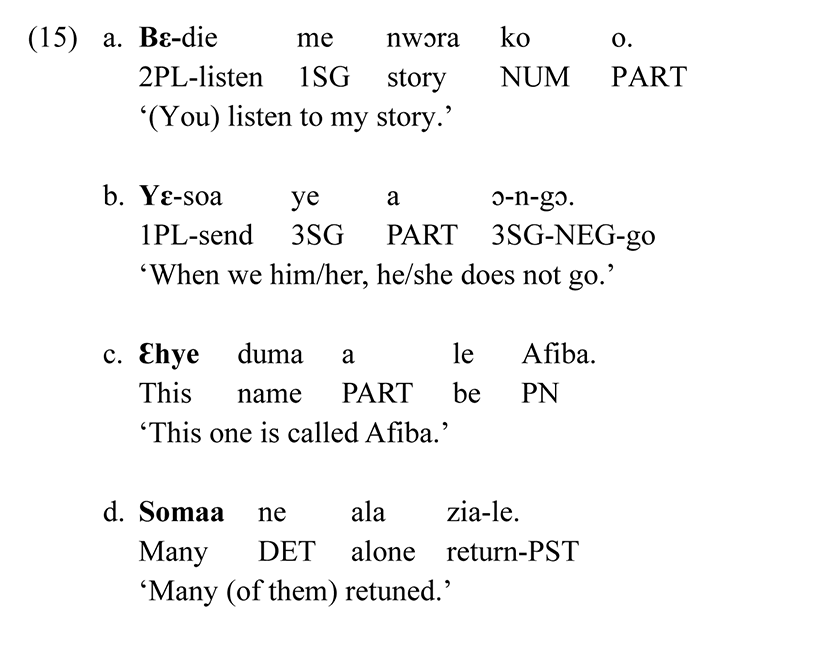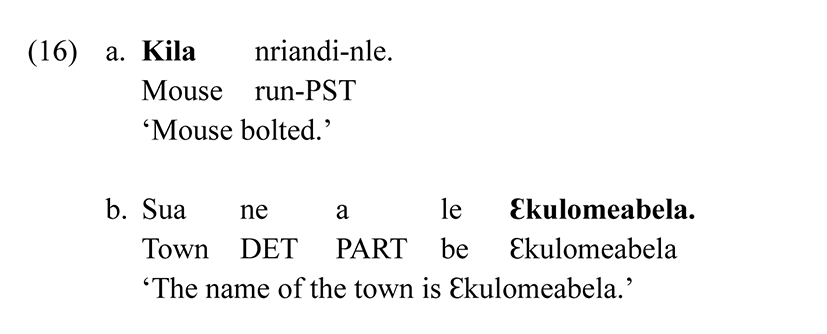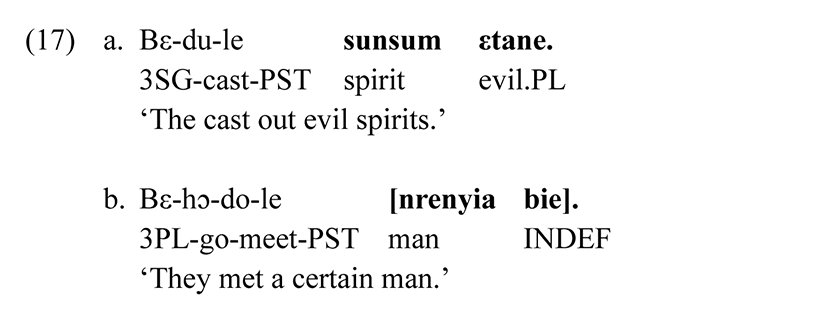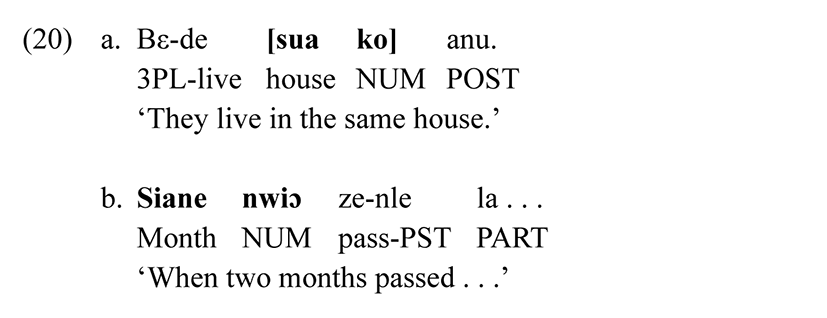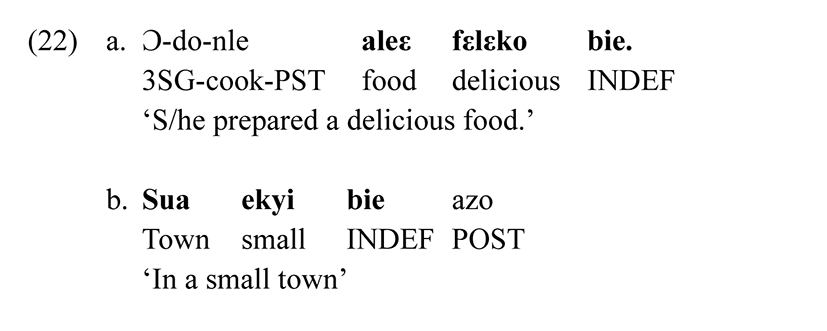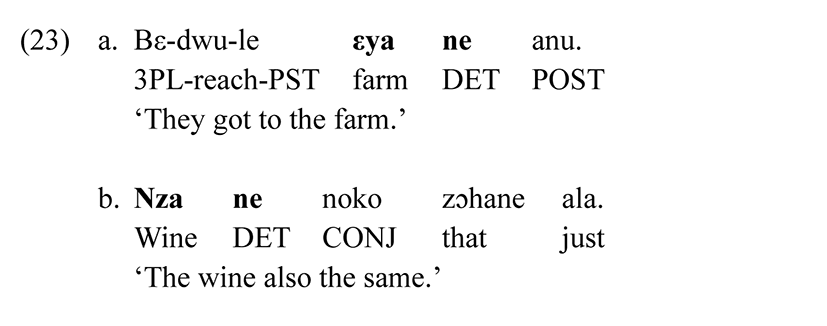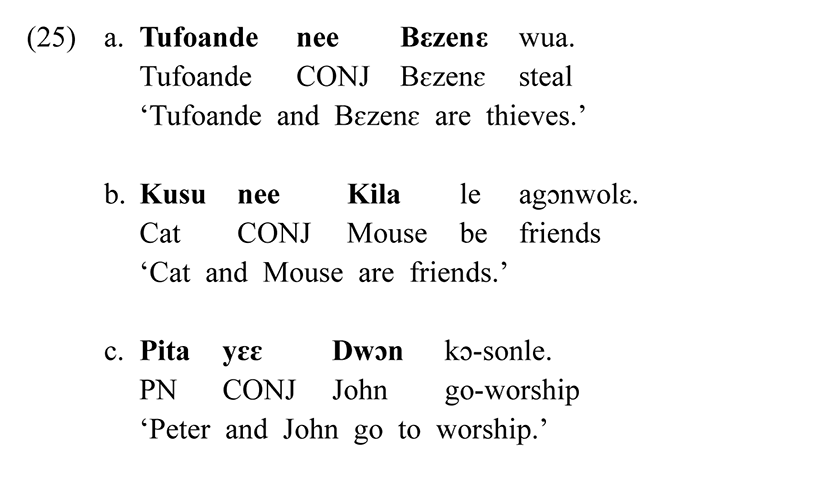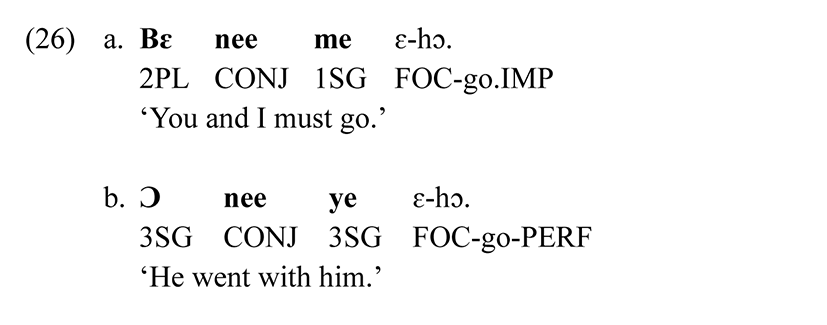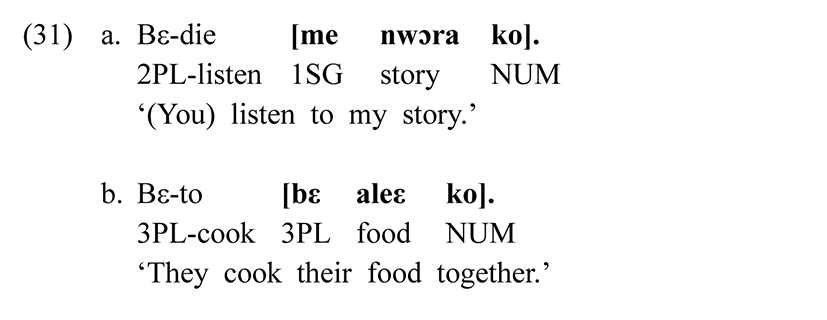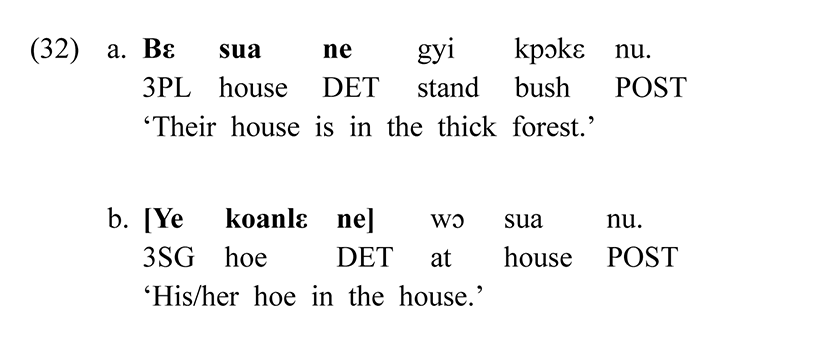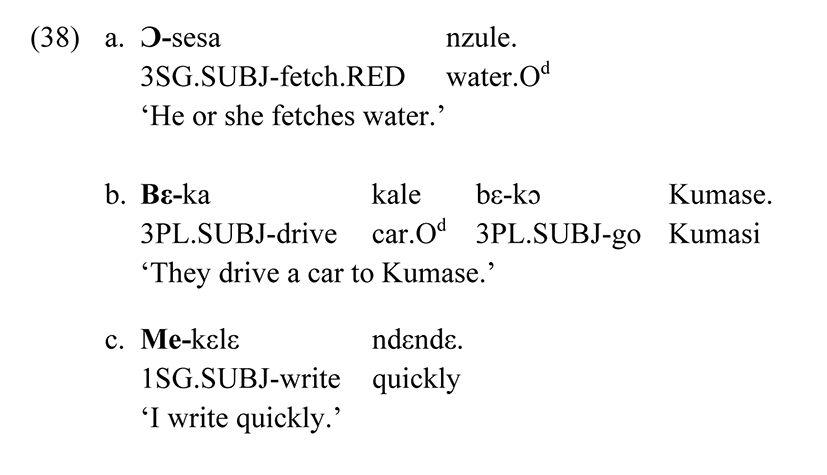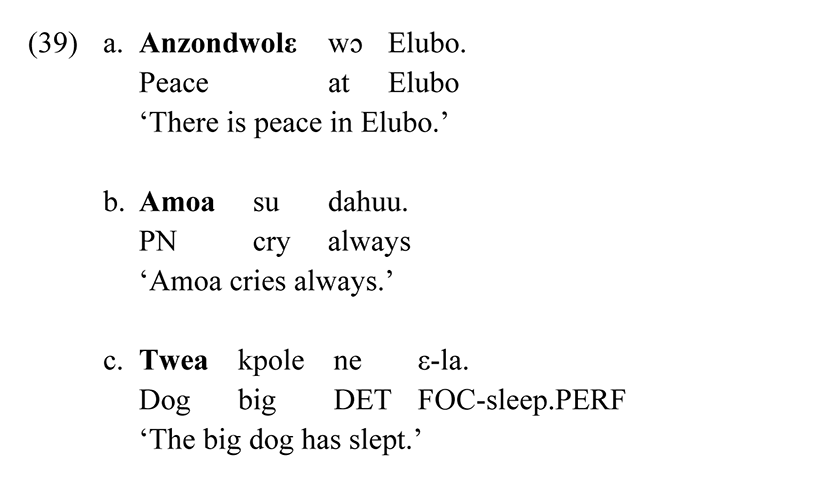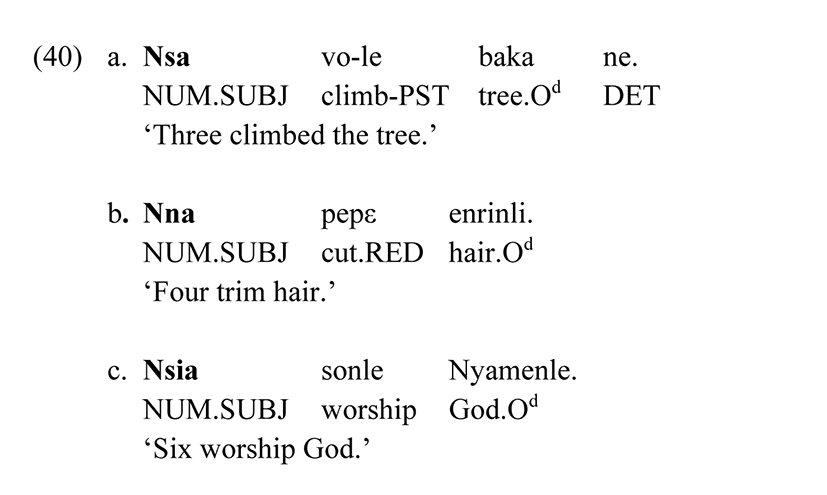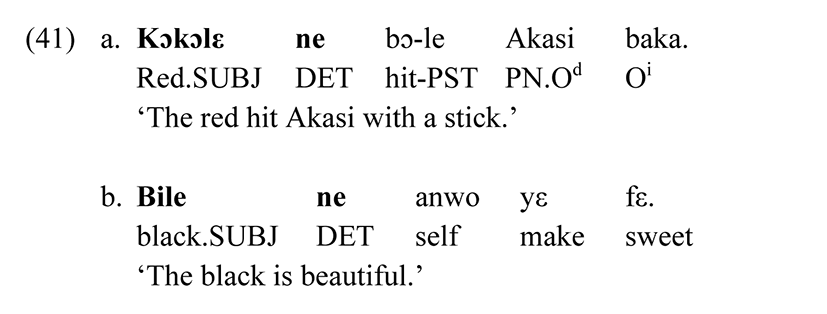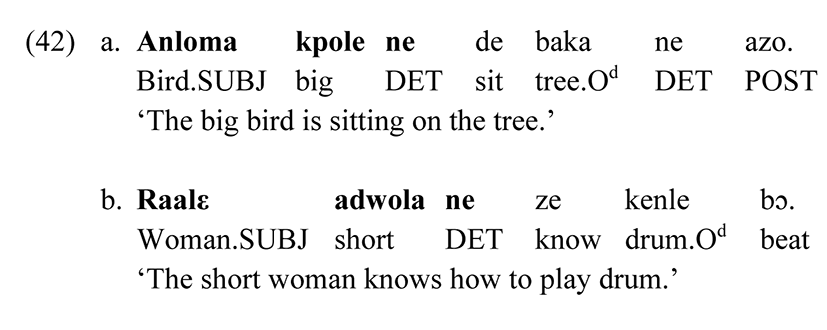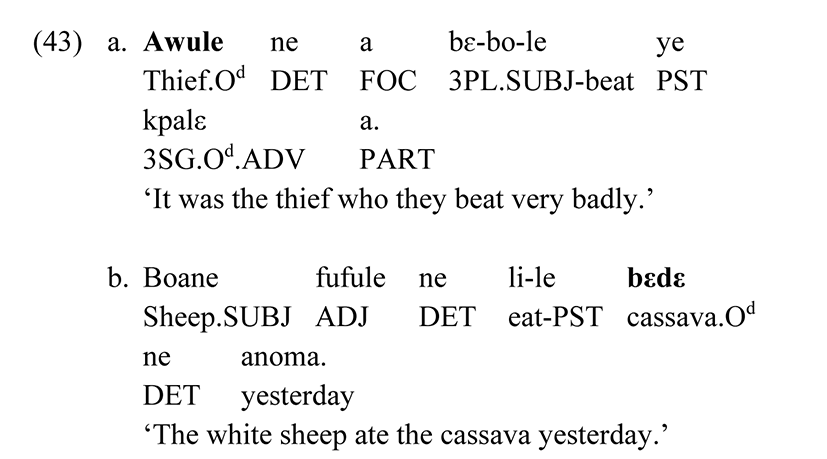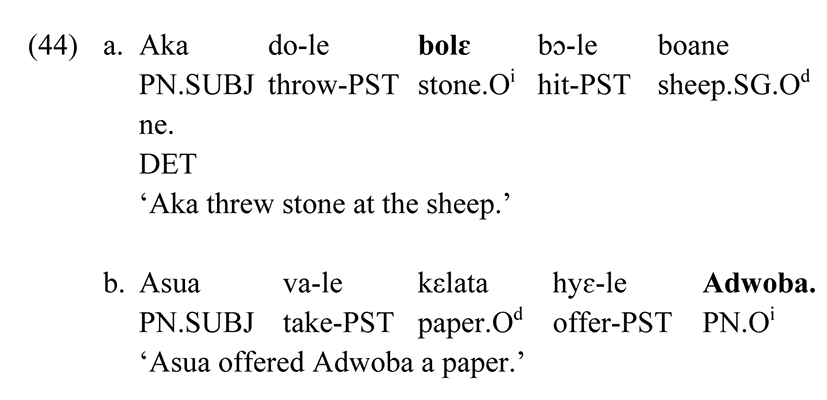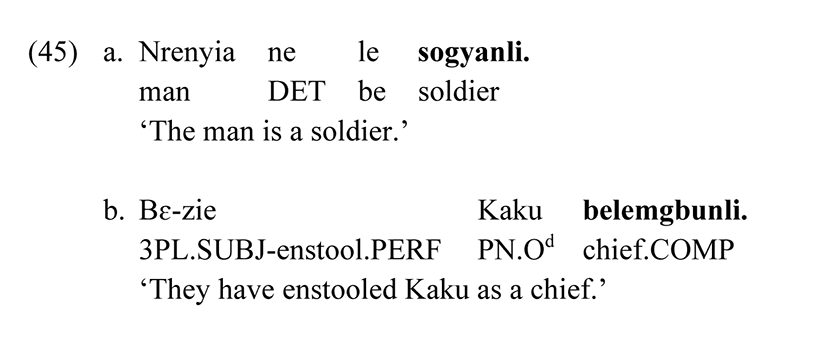1. Introduction
This paper investigates the structure, classification and functions of the Nzema NP. Nzema is a language spoken in the western region of Ghana. It is within the Kwa sub-branch of the Niger-Congo language family of West Africa. Nzema language has five dialects namely, Dwɔmɔlɔ, Ɛlɛmgbɛlɛ, Adwɔmɔlɔ, Egila and Ɛvaloɛ. The language has acquired literary status in Ghana and it is used both as a medium of instruction and as a subject of study in the few years of primary education and the JHS through to the university level. It is an examinable subject at all levels of education. It is taught at the University of Education, Winneba and also used on the national radio and television networks. The NP1 as an element of sentence structure has been the subject of much discussion in linguistics. Scholars of African linguistics who have variously discussed the structure of the NP include Angkaaraba (1980), Ourso (1989), Osam (1993), Ikoro (1996), Harvey & Reid (1997), Nsoh (2002), Ebule (2019). This study which looks at the structure, classification and functions of the Nzema NP is an extension of the discussion.
2. Literature Review
Nordquist (2019) defines NP as a word group with a noun or pronoun as its head and all the noun head accompanied by modifiers. Annan (2014) describes NP as that element in the sentence which typically functions as subject, object and complement. According to Annan (2014), the phrase is called an NP because the word which is its head is typically a noun. According to Simmons (2014), NP includes a noun (a person, place or thing) and the modifiers which distinguish it. Modifiers can come before or after the noun. Items that come before may include, articles, possessive noun, pronouns, adjective and particles. Huddleton (1998) also notes that an NP consists of a noun as head alone or accompanied by some dependents which precede the head. He distinguishes them into pre-head and post-head dependents. The pre-head dependents are of two main types, determiners and modifiers, and for the post-head dependents, he classifies them into clause structure-complements, modifiers and peripheral dependents. In the view of Crystal (1985), an NP is a group of words that includes an obligatory Head Noun (HN) and modifying elements. The HN acts as the center or core of the phrase.
In Dagbani, the NP is made up of the HN, which could be a bare noun, a pronoun, or proper noun, and several other elements which serve as modifiers (Issah 2013). The modifying words could be adjectives, quantifiers, demonstrative determiners, numerals and articles. These structural elements in the Dagbani NP occur as post-modifiers. According to Bodomo (1997), an NP in Dagaare may be composed of an HN such as a proper name, a bare noun or even a pronoun. Other elements within this configuration which serve to modify this HN may include any of the following: adjective, quantifier, demonstrative, intensifier, locative, article or even another NP. All these elements modify, qualify or say something about the head. According to Abdul-Razak (2015), Safaliba NP is made up of the obligatory HN and the optionally occurring elements; pre- modifiers and post-modifiers: the adjective and the determiner are analysed as modifiers. The Safaliba NP contains several post modifiers which are strictly ordered since each modifier has a prescribed syntactic position Abdul-Razak (2015). According to Bendor-Samuel (1971), the nominal phrase in the Gur languages consists of a noun followed by a numeral, or a noun followed by a demonstrative; but a noun followed by an adjective is not frequent, and a noun with a string of adjectives never occur. Angkaaraba (1980) argues that it is not a true reflection of the structure of the nominal phrase in the Gur languages. He adds that it is possible to have a string of adjectives modifying a noun in Dagaare contrary to Bendor-Samuel’s assertion. Angkaaraba’s (1980) assertion implies that structurally, the Dagaare NP, the Gurene NP and the Safaliba NP are similar, perhaps because they are all Gur or Mabia languages. In Nzema, the HN has pre-modifiers and post-modifiers as it is in Gurene, Dagaare and Safaliba.
Kwaw (2008), writing in Nzema, asserts that the Nzema NP is made up of the HN, which could be a noun or a pronoun and several other elements which serve as modifiers. Kwaw (2008) further explains that modifiers can come before or after the noun. An NP typically functions as subject, object, complement of sentences and as complement in prepositional phrases (Simmons, 2014). According to Boadi (2010), NP functions as subject, direct object and indirect object; and it may also function as adjunct of time, place, and manner. An NP is the main construction which can appear as the subject, object or complement of a clause. It consists essentially of a noun or noun-like word which is the most important constituent of the phrase (Crystal 1985).
It is obvious from the above that an NP is made up of the HN, which can be a pronoun or a noun with several other elements which serve as modifiers. Modifiers can come before or after the HN. Those that come before the head may include possessive pronouns and nouns. Those that come after the HN may include adjectives, quantifier pronouns, determiners, numerals or relative clauses. The Nzema NP equally has these elements as discussed partially by Kwaw (2008). What Kwaw (2008) fails to establish, however, is how these structures or elements are classified into simple, compound and complex types and how modifiers are distributed in the various structures of the Nzema NP. This is what the current paper seeks to address and also find out possible combinations that can function as subject, object and complement.
3. Methodology
The current paper is a qualitative study which uses a descriptive approach for all analysis. Data were gathered from both primary and secondary sources. The primary source is a collection of told stories. Before every story was told, we first sought approval from the respondents. We go to each of the respondent’s houses during dusk as it is the appropriate time folk tales are told. They usually gather the children before the stories are told. One story is told at each visit and was recorded. Most of the stories told had syntactic structures involving NPs which were recorded and transcribed. The secondary source, on the other hand, comprises biblical texts, drama and novel texts. One of the Nzema grammar books titled ʿNzema Aneεmεla Tagyee Neʼ by Kwaw (2008) was consulted. We took extracts from a novel titled “Ɛbɛlalekonle” written by Enoku Ɛzenrane (1992). Nzema Bible extracts (Acts 3: 1–10) and (Mathew 10: 1–10) taken from Baebolo anzɛɛ Buluku Nwuanzanwuanza written by Bible Society of Ghana (1998) which contained NPs were taken. Finally, “Ghana Aneε nee Maandeε” by Arde-Kodwo & Bonyah (2009) were also consulted. The data were analysed based on the structure, classification and functions of the Nzema NP. Observation cross-list of sentences were written to identify the structures, classifications and functions of the NPs in them.
4. Theoretical Framework
Descriptive Linguistics has undergone significant developments over the past century (Adell 2019). Today, most descriptive linguists are in agreement about the nature and goal of the discipline. Himmelmann (1998: 4) defines the end goal of descriptive linguistics as “the synchronic, non-prescriptive statement of the system of a given language.” It is quite distinguished from prescriptive linguistics, historical or comparative linguistics, and formal and explanatory theoretical approaches, such as the generativist paradigm. The aim of descriptive linguistics is to thoroughly describe individual languages while being maximally accountable to a naturalistic corpus of speech data (Ameka et al. 2006). According to Ameka et al. (2006), the data should ensure that the full variety of linguistic structures is represented, being carried out within the program of language documentation as envisioned by Himmelmann (1998). Dixon (1997: 133) says of linguistic description that “the analysis of a language implies recognising the operative elements of meaning, their underlying forms, and their combination and coding to produce a stream of speech.” Similarly, Haspelmath (2009: 378) defines language description as “the characterization of grammatical regularities of particular languages,” which includes generalized rules, schemas or constraints that can account for speakers’ ability to produce innumerable utterances. A primary goal of this description, according to Haspelmath (2009), is the accurate prediction of the linguistic behaviour of a speaker of a given language (as opposed to accurate characterization of internal generalizations made by the speaker.) A number of attempts have been made to outline explicit frameworks for language description and this theme has figured prominently in recent discussions among descriptivists (e.g., Dixon 1997, Dryer 2006, Haspelmath, 2009). Dixon (1997) suggested that much of contemporary descriptive practice be carried out within what he calls Basic Linguistic Theory, and this term has since gained attention in descriptivist circles, especially since it was adopted and defended by Dryer (2006) and others. Dryer (2006: 210) speaks of Basic Linguistic Theory as having arisen as “a convergence over the past quarter century in the descriptive tools assumed in descriptive grammars, to the extent that it is fair to say that a single descriptive theoretical framework has emerged as the dominant theory assumed in descriptive grammars.”
Dryer (2006) further argues that Basic Linguistic Theory is essentially conservative in its adoption of concepts unlike many theoretical frameworks that assume previous ideas only to a limited extent and freely assume many novel concepts, Basic Linguistic Theory takes as much as possible from earlier traditions and only as much as necessary from new traditions. It can thus be roughly described as traditional grammar, minus its bad feature with necessary concepts absent in the traditional grammar. It has supplemented traditional grammar with a variety of ideas from structuralism, generative grammar and relational grammar, and typology. The problem with Basic Linguistic Theory, as Adell (2019) points out, is that it has not been adequately defined, as has also been pointed out by Zaefferer (2006: 119) as follows: “I am not sure if such a theory can be identified or whether this is just a cover term for a wealth of overlapping but different sets of basic assumptions used in the work of ‘theory neutral’ descriptions in linguistics.” A clear statement of which descriptive tools have converged to produce the framework of Basic Linguistic Theory has also not been suggested. There is yet to be provided in the descriptions of Basic Linguistic Theory an outline of which concepts are possible to take from earlier traditions, nor which concepts from new traditions are necessary. At present, the proponents of Basic Linguistic Theory do not offer any identifiable criteria by which descriptive concepts may be assessed. Haspelmath suggests that what Dixon and Dryer may have in mind are concepts found in typologically oriented handbooks of grammar writing such as Payne (1997) and Shopen (1985). But even these do not agree in their use of terminology for fairly basic grammatical concepts. For instance, Payne (1997: 33) uses “grammatical categories” to refer to word classes, Shopen (1985), however, uses the same term to refer to formally encoded semantic distinctions. Thus, even in modern compendiums of descriptive concepts, terminology is often not commensurable.
Furthermore, while it is stated that “Basic linguistic theory differs from traditional grammar most strikingly in its attempt to describe each language in its own terms, rather than trying to force the language into a model based on European languages” (Dryer 2006: 211), it is unclear how a language may be described in its own terms if there is no room for the creation of novel concepts. As was seen above, while Dryer leaves some room in Basic Linguistic Theory for the conservative adoption of new concepts from frameworks outside traditional grammar (e.g., generative grammar, relational grammar, typology) there seems to be an implicit assumption that novel concepts are to be avoided. This logic is self-defeating. If linguists over the course of the last century had not felt free to assume novel concepts, languages would still be described in terms of European languages. Haspelmath (2009) has argued similarly against the use of Basic Linguistic Theory—and against restrictive theories in general—on the basis that it is antithetical to the Boasian dictum that languages should be described in their own terms. Haspelmath (2009) argues that if one approaches a language with a presupposed set of conceptual possibilities from which he or she must choose, impartiality and open-mindedness are forfeited. This is particularly problematic given that the meanings and formal properties of grammatical categories seem to be language-specific requiring unique analyses for each language. Thus, we agree with Haspelmath (2009: 394) that “grammar authors have to be ready to create completely novel concepts, because no two categories are completely identical across languages, and often the categories are not even particularly similar across languages. If one approaches a language with a particular set of concepts and tools in mind, one is no longer open-minded and bias-free.” The alternative to Basic Linguistic Theory, as proposed by Haspelmath (2009) is a framework-free grammatical description, or a non-commitment to any system which imposes a fixed set of presuppositions about which concepts may be used in the description. Among the most important methodological principles of descriptive linguistics is the use of natural language as the metalanguage for description, which contributes to the accessibility, readability and longevity of a grammar. A related principle is the careful use of terminology, including clear definitions for language particular categories, and the avoidance of theory-specific language-opting instead for terms that will be recognized by linguists of any persuasion. While some have suggested that using familiar terminology allows the reader to access data more quickly, others (e.g., Dixon 2010) have cautioned that terminology must be carefully applied, due to the fact that many terms have multiple potential meanings. Adell (2019) admits that it is not possible to avoid theoretical or terminological problems entirely, the best practice is to be aware of potential issues and to employ careful language and clearly defined terms. There is also overwhelming general agreement that languages should be described in their own terms, meaning that language-specific categories are unavoidable.
Descriptivists also agree that grammars should strive for descriptive adequacy, both in terms of their extent and justification. This means that grammars ought to be as comprehensive as possible, and linguistic phenomena should be described in sufficient detail. Both the evidence and accompanying analyses should be presented in a way that allows the reader to understand the argument, and to connect it to the rest of the grammar. Thus, sufficient evidence and analysis include extensive cross-referencing, morpheme by morpheme glossing, and ideally, access to the broader context from which examples are drawn, either by presentation of texts in the grammar, or by providing reference to the corpus itself via a digital archive. These considerations have informed the nature of the present paper, in which we have attempted to follow the principles in contemporary descriptive practice described above as closely as possible. This paper is thus intended to be a data-driven that seeks to describe the Nzema language in its own terms.
5. Data Presentation and Discussion
The Nzema NP is made up of the HN, which could be a noun or a pronominal and several other elements which serve as modifiers. Modifiers can come before or after the HN.
The Nzema NP may be a pronoun only without a modifier. The NP which consists of pronoun only can be personal pronoun or quantifier pronoun. Here are examples:
The bolded parts in the examples above are the pronoun-only noun phrases. Dɔɔnwo ‘many’ and boni ‘which’ in (1a) and (1b) are quantifier pronoun and interrogative pronoun respectively. . ‘he/she’ in (1c) and me ‘I’ in (1e), respectively are the personal pronouns. Ɛhye ‘this’ in (1d), is a demonstrative pronoun.2
Another NP structure in Nzema is that which can be noun only. The Nzema NP which consists of noun only can be proper noun, common noun and abstract noun. Here are examples:
The bolded elements in the examples above are the noun only in the respective noun phrases. Afiba and Anwi in (2a) and (2b) respectively are proper nouns. Anwonyane ‘sickness’ and adwongu ‘ankle’ in (2c) and (2d) are abstract and common nouns respectively. The examples, with the exception of (2d) in which the NP is modified by the determiner ne ‘the’, the other NPs occur without a modifier.
Another NP structure in Nzema has noun and determiner. The head noun is post-modified by the determiner. Here are examples from the data.
The bolded phrases in (3a)–(3d) above are of the structure; noun + determiner. Ԑya ‘farm’, in (3a) is the head noun and is post-modified by the determiner ne ‘the’. Sua ‘house’, in (3b) is the head noun and is post-modified by the determiner ne ‘the’. Raalε ‘woman’, in (3c) is the head noun and is post-modified by the determiner ne ‘the’. Ewia ‘sun’, in (3d) is the head noun and is post-modified by the determiner ne ‘the’. The determiner ne ‘the’ attached to the respective head nouns specify exactly which items are talked about.
The structure of the NP may also be a string of three nouns with or without a determiner. Below are examples from the data collected:
The bolded phrases in the sentences above involve a string of three nouns without a determiner. Azua ‘villages’ in (4a) which is the third noun in the phrase is the head noun, and it is pre-modified by Ɛnweazo ‘coast’, the second noun and kɔnwɔnzenra ‘crab’ the first noun. Bokiti ‘bucket’ in (4b) which is the third noun in the phrase is the head noun, and it is pre-modified by wolɔba ‘rubber’, the second noun and Elubo the first noun. The two nouns which pre-modify the head nouns are functioning as adjectives and for that reason are modifiers.
The Nzema NP may also consist of a noun and an adjective of which the head, which is the noun is post-modified by the adjective following it. Consider the examples below:
From the bolded phrases (5a)–(5d) above, we see the structure noun + adjective. Anlenkε .door’, in example (5a) is the head noun, and it is post-modified by the adjective kεnlεma ‘beautiful’. Sunsum ‘spirit’ in (5b) is the head noun, and it is post-modified by the adjective εtane ‘evil’. Anwi in (5c) is the head noun, and it is post-modified by the adjective kakula ‘young’. In (5d), however, nrenyia ‘man’ which is the head noun is post-modified by the adjective belane ‘fat’ and the determiner ne ‘the’.
Another structure of the Nzema NP has a noun as head and post-modified by an adjective or a pronominal. Examples are shown below:
The bolded phrases in (6a) and (6b) above are of the structure noun + adjective + quantifier pronominal and noun + adjective + demonstrative pronominal.Aleε ‘food’ in (6a) is the head noun, and it is post-modified by the adjective fεlεko ‘sweet’ and the quantifier pronominal bie ‘some’. Raalε ‘woman’ in (6b) is the head noun, and it is post-modified by the adjective adwola ‘short’ and the demonstrative pronominal εhye ‘this’.
This structure of the Nzema NP has a noun as head with a numeral and determiner as modifiers. Find examples below:
From the bolded phrases in (7a) and (7b) above, sua ‘house’ and abusua ‘family’, are the head nouns which are post-modified by the numerals ko ‘one’, and nwiɔ ‘two’ respectively.
The Nzema NP may have a structure containing a noun with more than one modifier. The initial modifier may be another noun or an adjective while the final modifier is usually a determiner. Here are examples from the data collected:
The phrases in the examples above constitute a modifier + noun + adjective structure. Raalε ‘lady’ in (8a) is the head noun, and it is pre-modified by the noun kilehilevolɛ ‘teacher’ and post-modified by the adjective bile ‘dark’, and the determiner ne ‘the’. Nrenyia ‘man’ in (8b) is the head noun, and it is pre-modified by the adjective sukoavolε ‘rich’, and post-modified by another adjective adwola ‘short’.
Another NP structure in Nzema is of the form, noun + noun. In this structure, the two elements together are the head of the phrase even though there is only one principal item focused in the phrase. Let us consider the examples below:
The bolded phrases in (9a)–(9c) above are a string of two nouns heading the NPs. Thus, Gyawue in (9a) which is the second noun3 in the phrase is the principal head noun, and it is pre-modified by sua ‘town’. Nzule ‘water’ in (9b) which is the second noun in the phrase is the principal head noun, and it is pre-modified by Ngεnla ‘Accra’. Raalε ‘girl’ in (9c) which is the second noun in the phrase is the principal head noun, and it is pre-modified by namule ‘village’.
In this NP structure, the initial element which is a noun, is the head noun of the phrase and is post-modified by a numeral and a determiner. Here are examples:
From the bolded phrases the above, nεεsema ‘nurses’ in (10a) is the head noun, and it is post-modified by the numeral ngɔnla ‘nine’ and the determiner ne ‘the’. Also, kilehilevolεma ‘teachers’ in (10b) is the head noun, and it is post-modified by the numeral abulanwiɔ ‘twenty’ and the determiner ne ‘the’.
Another Nzema NP structure which has been identified in the data is pronoun + noun + determiner. The noun is the head and it is pre-modified by the possessive pronominal and post-modified by the determiner. Here are examples:
The bolded phrases in (11a)–(11c) above have the structure; pronoun + noun + determiner in the respective NPs. Tεladeε ‘shirt’ in (11a) is the head noun, and it is pre-modified by the possessive pronominal ye ‘his/her’, and post-modified by the determiner ne ‘the’. Koanlε ‘hoe’ in (11b) is the head noun, and it is pre-modified by the possessive pronominal4wɔ ‘your’ and post-modified by the determiner ne ‘the’. Nzule ‘water’ in (11c) is the head noun, and it is pre-modified by the possessive pronominal bε ‘their’, and post-modified by the determiner ne ‘the’.
Another Nzema NP which has been identified in the data has this structure: noun + relative clause. The noun is the head which is post-modified by the adjective/relative clause.
Gyisεse Kelaese ‘Jesus Christ’ in (12a) which is the head noun, is post-modified by the relative/adjective clause mɔɔ vi Nazalεte ‘who comes from Nazareth’. In (12b), mɔɔ nea sua ne azo la ‘who watches over the house’, post-modifies the head noun, Kabenla.
The NP in Nzema may also have this structure: noun + conjunction + noun. In this NP structure, there are no overt modifiers. Thus, the two NPs, joined by the conjunction, are the head nouns of the phrase. Here are examples from the data collected:
Each of the bolded NPs in the examples above has two nouns which together are the head nouns of the phrase. Thus, bote ‘rat’ and kila ‘mouse’, and Aka and Kofi, joined by the conjunction nee ‘and’ in each, respectively are the head nouns of the phrases.
The Nzema NP may also constitute two sets of nouns joined by a conjunction in its structure. Here is an example below:
The NP in the example above is made up of two separate NPs: manra sua ‘raffia house’ and ndɛtɛlɛ sua ‘mud house’ joined by a conjunction. It should be noted, however, that, sua ‘house’ in both constituents is the principal head while pre-modified by manra ‘raffia’ and ndɛtɛlɛ ‘mud’ respectively.
The NP in Nzema, according to the data and which have been identified, can be classified as simple, compound and complex.
The Simple NP in Nzema takes single heads and may be a pronoun only or noun only without a modifier. The simple NP which consists of pronoun only can be personal pronoun, demonstrative pronoun or quantifier pronoun. Let us consider the examples below:
From the examples (15a)–(15d), bε ‘you’ and yɛ ‘we’ which are personal pronouns, and ɛhye ‘this’ and somaa ‘many’, which are also demonstrative pronoun and quantifier pronoun respectively, are the head nouns of the phrases. Another simple noun phrase type in Nzema is the noun only which can be a proper noun or common noun without a modifier. Let us look at the following examples:
From the bolded NPs (16a) and (16b), kila ‘mouse’ and Ɛkulomeabela, which is a name of a place are common noun and proper noun respectively. It can be seen from the above that the simple noun phrase has a structure whose head noun is not joined by any coordinator or subordinator. This way, only one item is talked about.
The Nzema simple NP may also have the head noun as a common noun post-modified by an adjective or quantifier pronoun. Below are examples:
From the examples in (17a) and (17b), sunsum ‘spirit’ and nrenyia ‘man’ are the respective head nouns in both phrases, modified by the adjectives ɛtane ‘evil’ and bie ‘certain/some’.
When the simple NP consists of two nouns as in (18) below, the initial noun functions as a modifier.
Gyawue which is the second noun in the NP is the head noun, and it is pre-modified by sua ‘town’, the first noun. The simple NP may also have pronoun + noun combination. In this combination, the pronoun is a possessor and also modifies the noun as shown below.
Me nlɔnra ‘my grandchildren’ in (19) is a simple NP. Nlɔnra ‘grandchildren’ is the head noun, and it is pre-modified by the possessive pronominal me ‘my’.
The Nzema simple NP can also have noun + numeral. The numeral is however optional. Here are examples:
The bolded NPs in the above are simple. From (20a), (20b), the head noun in each is sua ‘house’ and siane ‘month, which are respectively post-modified by the numeral ko ‘one’ and nwiɔ ‘two’.
The simple NP may also have the structure: N + Adj + Det. Below is an example from the data collected:
The head noun of the bolded NP above in (21), kpɔkε ‘bush’, is post-modified by the determiner ne ‘the’. When the determiner ne ‘the’, which is the only definite article5 in Nzema, occurs in isolation with a noun, it functions as an adjective and therefore modifies the noun. Therefore in a simple structure such as in the above, the determiner may occur as optional element since it modifies the noun.
Another Nzema NP which is classified as simple has the combination: noun + adjective + quantifier pronoun. The noun is the head and it is post-modified by an adjective and a quantifier pronoun which may occur as optional elements. Below are examples from the data:
In (22a) and (22b), the head nouns of the NPs aleε ‘food’ and sua ‘house’ are respectively post-modified by an adjective and a quantifier pronoun fεlεkobie ‘a delicious’ and ekyi bie ‘a small’. Moreover, simple NP in Nzema has this structure: noun + determiner. The head noun is post-modified by the determiner.
In the examples (23a) and (23b) above, the bolded parts in the sentences, ɛya ‘farm’ and nza ‘wine’, are the head nouns of the respective NPs which are post-modified by the determiner ne ‘the’. Even though the head nouns are qualified by the definite article and for that matter determiner, the phrase in general speech may raise questions such as ‘which farm?’, ‘whose farm?’, ‘what wine?’, ‘which wine?’ and which may need further clarification.
The Nzema simple NP may have noun + numeral + determiner in its structure. In this simple NP type, the head noun is modified by a numeral and a determiner as in the example below.
From the example in (24), the focus is on abusua ‘family’ and thus the head of the NP. To make it clearer the particular abusua ‘family’ that is talked about, it is pre-modified by the numeral nwiɔ ‘two’ and the determiner ne ‘the’.
The Nzema compound NP is made up of two NP joined by a conjunction. Its structure may be two nouns joined by a conjunction, two pronouns joined by a conjunction, a noun with its modifier plus another noun with its modifier joined together, a noun and another noun plus an adjective or a pronoun and a noun joined by another pronoun and a noun. Below are examples of compound phrases involving two nouns joined by a conjunction:
In each of the examples above, the bolded NP has a compound structure. The head of the NPs: Tufoande, Bɛzenɛ, Kusu, Kila and Peter, John are all joined by the conjunction nee and yɛɛ ‘and’. We see that the compound head word in this category can be either proper nouns or common nouns as in (25a)–(25c) above.
As indicated, the compound noun phrase may consist of two pronouns joined by a conjunction as the head as shown below:
From the above examples, we see that the bolded; bɛ ‘you’, me ‘me’, and . ‘s/he’ and ye ‘him/her’ are joined by the conjunction nee ‘and’ to mean that two items are talked about at the same time and for that matter, the head of the sentence.
The two nouns which both head the compound NP may take modifiers. Let us see from the example below:
The NP in (27) above has this structure: modifier + noun + modifier + noun. Thus, abεlε amuku ‘maize flour’ and arεlε nwole ‘palm oil’ are two separate NPs joined by the conjunction nee ‘and’. In Nzema, when two nouns follow each other as in the above, the second noun functions as head noun and the first functions as a modifier. It must be emphasised also, that, there can be pre-modifiers as well as post-modifiers. However, in a structure where there are two modifiers, the second is usually an adjective. See from the example below.
As can be seen from (28), the two modifiers, abɛlɛ ‘maize’ and dɛba ‘old’, are noun and adjective respectively. The post modifier, dɛba ‘old’ is an adjective indicating age. Again, the Nzema compound NP can also have the structure, noun + conjunction + noun + adjective. Here is an example from the data collected:
The head noun of the first NP is Adu and the head noun of the second NP is Edobo. The two NPs are joined by the conjunction nee ‘and’. The second NP is however post-modified by an adjective fofolɛ ‘new’.
The Nzema compound NP may also be of this structure; pronoun + noun + conjunction + pronoun + noun. Here is an example:
From the example in (30), the head noun of the first NP ti ‘head’ and that of the second NP bo ‘bottock’ are both pre-modified by the possessive pronominal bɛ ‘they/their’ and are joined by the conjunction nee ‘and’.
The Nzema complex NP consists of an HN with some syntactic modifiers including adjectives, determining nouns, relative clauses and appositions. These syntactic modifiers normally pre-modify or post-modify the HN. Due to its complex structure, it has varying elements that make up the phrase. Let us consider the examples below:
The bolded in the brackets are the NPs. The complex noun phrases in each sentence are literally translated thus; my story one and their food one respectively. Nwɔra ‘story’ and aleε ‘food’ are the respective head nouns in the examples, and are pre-modified by the pronominal me ‘my’, and bε ‘they’ and post-modified by the numeral ko ‘one’.
Another complex NP which has been identified in the data has the structure pronoun + noun + determiner. The noun is the head which is pre-modified by pronoun and post-modified by the determiner. Examples:
The NP in each of the sentences above is complex. Sua ‘house’ in (32a) is the head noun which is pre-modified by the possessive pronominal bε ‘their’, and post-modified by the determiner ne ‘the’. The NP in (32b) has koanlε ‘hoe’ as the head noun. It is pre-modified by the possessive pronominal ye ‘his/her’, and post- modified by the determiner ne ‘the’.
The Nzema complex NP can also have a noun + adjective + noun + adjective. Here is an example from the data collected:
The bolded NP in (33) above is complex in that it has two independent noun phrases; gua ‘street’ and kono ‘road’ which are individually qualified by the adjectives bile ‘black’ and kpole ‘big’ respectively.
Another complex NP which has been identified in the data has the structure: noun + relative clause. The noun is the head which is post-modified by the relative clause. Consider the example below:
The NP above is a complex one. Gyisεse Kelaese ‘Jesus Christ’ which is the head noun of the phrase is modified by a relative clause, which is also a subordinate clause. Thus the relative clause mɔɔ vi Nazalεte ‘who come from Nazareth’ provides more information about the particular ‘Jesus Christ’ being talked about.
The structure of the complex NP may consist of three successive nouns and a determiner. Here is an example from the data:
In (35), azua ‘towns’ which is the third noun in the NP is the head noun, and it is pre-modified by Ɛnweazo ‘Coast’, the second noun and kɔnwɔnzenra ‘crab’ the first noun and post-modified by the determiner ne ‘the’. This shows that in Nzema, there can be more than two successive nouns in a phrase in which the final among them is the head noun. The complex NP may also have a noun as head with two or more adjectives modifying it as in the example below.
In the complex noun phrase bolded, the head noun of the NP is raalε ‘girl’ and is pre-modified by the adjective kakula ‘young’, and post-modified by the adjectives kɔkɔlε ‘fair’ and anwofɛlɛko ‘beauty’.
The Nzema complex NP may also consist of three serial nouns with no intervening element. Here is an example from the data presented as example (37) below.
In the above example, Maanzinli ‘Municipality’ which is the third noun in the NP is the head noun, and it is pre-modified by Nzema ‘Nzema’, and Sɛnzεndɔleε ‘West’. From our discussions so far, it has been made clear that when two nouns follow within the same phrase, the initial modifies the final. In (37), however, it is noteworthy that because the nouns are more than two, the head noun moves to the third position. This way, the initial two nouns modify the third noun.
The Nzema NP can function as: subject, direct object, indirect object and complement. The subject is a part of a sentence that contains the person or thing performing the action in a sentence. The subject in the context of Nzema can be pronoun only, noun only, number only, adjective only or noun + adjective + determiner. Below are examples of pronoun functioning as the subject.
The bolded parts in the examples above are functioning as subjects in the respective NPs (38a)–(38c). Thus, ɔ ‘he or she’, bε ‘they’ and me ‘I’ in (38a)–(38c), are personal pronouns that stand in the context and perform the action of ‘fetching’, ‘driving’ and ‘writing’ respectively. Let us consider the following in which nouns are the subject.
In the examples, anzondwolε ‘peace’ which is an abstract noun, Amoa which is a personal name, and twea ‘dog’ in (39a)–(39c) respectively are performing the action of ‘being’, ‘crying’ and ‘sleeping’ and therefore are subjects of the respective sentences above. The examples below have numerals as the subject.
From the examples above, nsa ‘three’, nna ‘four’ and nsia ‘six’ are NPs functioning as the subjects in the respective sentences (40a)–(40c). As hinted earlier, the subject of the NP may be adjective with a determiner as its modifier.
As can be seen from the examples above, the adjectives kɔkɔlɛ ‘red’ and bile ‘black’ are the respective head nouns and subjects of the NPs (41a) and (41b). In (42a) and (42b) below, the subject has the constituents; noun + adjective + determiner.
The bolded parts in (42a) and (42b) above are NPs functioning as subjects in the respective phrases. Thus, anloma ‘bird’ which is the HN and post-modified by the adjective kpole ‘big’ and the determiner ne ‘the’, together function as the subject of the phrase. Also, raalε ‘woman’ in (42b) as the HN and post-modified by the adjective adwola ‘short’ and the determiner ne ‘the’, together function as the subject of the phrase.
The Nzema NP can function as direct object. The direct object refers to the person or thing affected by the action of the verb. Here are examples below:
The bolded parts in (43a) and (43b) above are the direct objects receiving the action of ‘beating’ and ‘eating’ by their respective subjects, bɛ ‘they’ and boane ‘sheep’ of the NPs.
Moreover, the Nzema NP can function as the indirect object of the phrase. The indirect object is a noun or pronominal to who or what, for whom or what an action is completed. In other words, the indirect object refers to the person (noun) who benefits from an action or receives something as a result of it. Here are examples.
The bolded elements in (44a) and (44b) above, bolɛ ‘stone’ and Adwoba ‘a personal name’, are NPs functioning as indirect objects in their respective phrases.
The Nzema NP can also function as complement of the sentence. Complement is a thing that contributes extra features to something else in such a way to improve or emphasize its quality. In other words, it is the part of the NP which provides more information about the subject.
From the examples above, the bolded are the NPs functioning as complements in the respective sentences. Thus, sogyanli ‘a soldier’ and belemgbunli ‘chief’ in (45a) and (45b), providing more information about the subjects, nrenyia ‘man’ and Kaku ‘a personal name’ respectively in the phrases are complements to the subjects.
6. Conclusion
The paper has shown that the Nzema NP is made up of an obligatory HN which could be a bare noun or a pronominal. The head noun may be modified by an adjective, a determiner, a relative clause, a numeral or another noun. Modifiers can come before or after the HN. The NP in Nzema can be classified as: simple, compound and complex based on their structure. Structurally, the simple NP is made up of an obligatory HN or pronoun with no modifying elements. The compound NP is made up of two NPs joined by a conjunction; and the complex NP consists of a HN with some syntactic modifiers including adjectives, determiners, nouns and relative clauses. These syntactic modifiers normally pre-modify or post-modify the HN. It has also been shown that nouns, pronouns, adjectives or numerals can occur as head nouns of the Nzema NP. The items that occur as pre-modifiers could be a possessive pronominal or a noun. Also observed is the fact that the items that occur as post-modifiers in the NP are numerals, quantifier pronouns, determiners, adjectives, and relative clauses. Syntactic modifiers including adjectives, determiners, numerals and relative clauses occur in a restricted order. That is, they do not follow haphazardly. Three items which cannot occur in a pre-modifying position are adjectives, determiners and numerals. Personal pronouns, demonstrative pronouns, interrogative pronouns and indefinite pronouns can occur as head. When the head is a numeral or an adjective, it cannot be pre-modified, but it can be post-modified. The head of the NP is an obligatory element, however, pre-modifiers and the post-modifiers occur as optional elements. The Nzema NP can function as subject, object or complement.







